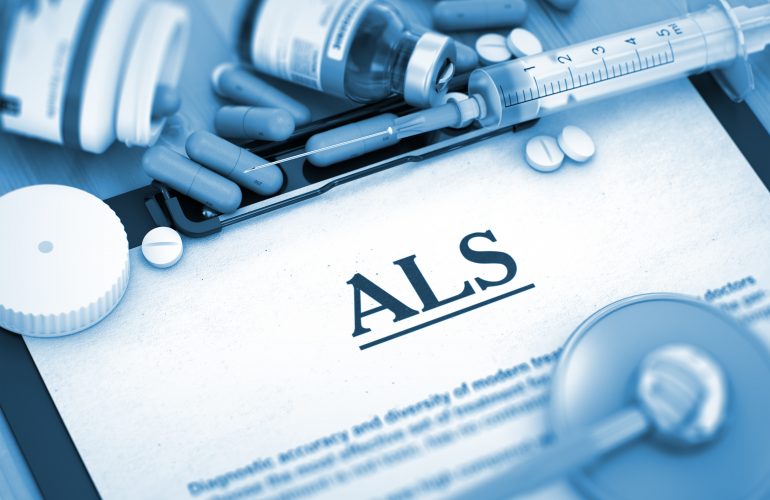Some people call Amyotrophic Lateral Sclerosis Lou Gehrig’s Disease or simply ALS. Whatever it’s called, ALS is a devastating and terminal neurodegenerative disease that has a highly predictable clinical course. It is also known as a motor neuron disease as well as a progressive neuromuscular disease that attacks nerve cells and pathways in the brain and spinal cord. Motor neurons reach from the brain to the spinal cord and then from the spinal cord to a muscle or gland in the body. When motor neurons die, the brain can no longer start or control muscle movement. Unfortunately, there currently is no cure for ALS and people diagnosed with it gradually lose the ability to move, and will eventually be overtaken by complete paralysis.
Who is at Risk for ALS?
Around 20,000 Americans have ALS, and each year brings another 6,000 new cases. Symptoms begin between the ages of 40 to 70 but there are cases both earlier and later. Most people will survive for only 3 to 5 years after the diagnosis is confirmed. Around 10% of people with ALS will survive for 10 years or slightly more. ALS occurs more in men than in women. One type of ALS in which there is no known cause, “Sporadic ALS”, accounts for between 90% to 95% of all cases. The other type, “Familial ALS” is inherited and accounts for between 5% to 10% of all cases.
(NOTE: Interested in learning more about Neurodegenerative Disorders? Checkout my Neurodegenerative Disorders on CEU Academy and try a FREE CEU today!)
Symptoms of ALS
The person first becomes aware of the onset of ALS when their hands become clumsy, which causes difficulty performing minor tasks like writing or unlocking a door with a key. Some people will experience weakness in their legs and may trip, stumble or fall. ALS is usually present for some time before any symptoms present themselves and the person becomes aware there is a problem. Generalized fatigue is another symptom that can develop in the early stages of the disease. Signs begin in the hands and feet and then travel toward the center of the body. Generally, one side of the body is more affected than the other.
As ALS progresses, symptoms become worse. The person may experience stiffness in their joints and muscles, occasional jerking movements of arms or legs and twitching. Some people will experience “Pseudobulbar Affect”, which is a condition characterized by uncontrollable laughter or crying. The later stages of the disease usually bring greater depression, drooling, cognitive impairment, and changes in the person’s behavior. Personality and language skills deteriorate and Frontotemporal Dementia (FTD) may develop before death.
Special Care Issues
Caring for the individual with ALS can be very complex and demanding. Special medications (Radicava and Rilutek) may be prescribed. Weight and diet are two of the most important aspects of caring for people with ALS. Those with a normal to higher Body Mass Index or BMI may survive longer than those with a lower BMI. High-carbohydrate, hypercaloric diets may be necessary. Mild to moderate exercise can be helpful to reduce spasticity and muscle spasms. Physical therapy can also help the person with resistance and aerobic exercise, range of motion, and stretching.
Hypersialorrhea, or hyper-salivating, is a frustrating and embarrassing problem for the individual diagnosed with ALS. It is also a dignity issue. The excessive drooling can result in choking and aspiration pneumonia. It can also interfere with communication, which is another important area of care. Pulmonary issues will develop and respiratory failure is the leading cause of death among people with ALS. Other special care issues include treating and managing pain, helping the person with immobility and trying to maximize their quality of life throughout the disease process.
Final Words on Amyotrophic Lateral Sclerosis
We can call the disease Amyotrophic Lateral Sclerosis, Lou Gehrig’s Disease or ALS, but the bottom line is that it is a devastating neurodegenerative disorder that begins with a nightmarish diagnosis from a specialist and ends in complete disability and death. It is by far, one of the worst neurodegenerative disorders known to humankind. As the disease progresses, everyone around and including the person diagnosed with the disease, will suffer and this can go on for 3, 5, or 10 years. Most people will decline aggressive treatment, receive palliative care and eventually hospice. People with ALS deserve the best care and quality of living while they still can.
(NOTE: Interested in learning more about Neurodegenerative Disorders? Checkout my Neurodegenerative Disorders on CEU Academy and try a FREE CEU today!)

